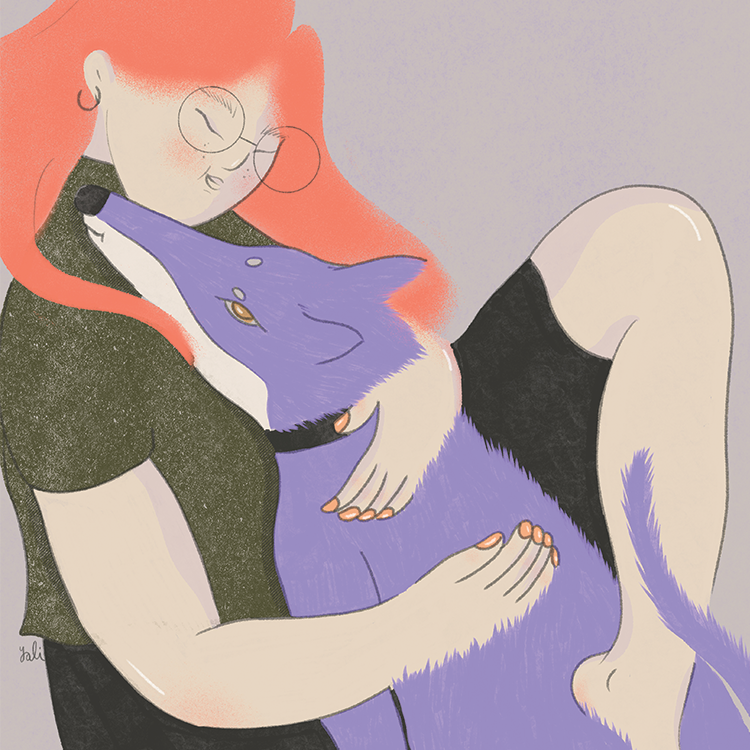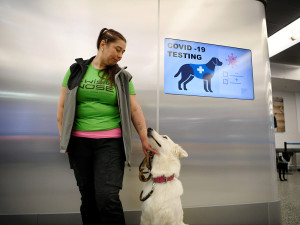Your Dog Can Smell When You’re Stressed, New Study Says
Research finds that your pup can smell when you’ve been doom-scrolling, and they get bummed out.

share article
If you’ve ever tried to hide treats from your dog, you know they can sniff out chicken, steak, hot dogs, peanut butteropens in a new tab, and even a small bit of cookie stuck in the fold of your sweater. Trying to hide anything with an odor from our dogs is pointless. Turns out, one of those things is our stress, and yes, dogs can smell that, too.
A study led by University of Bristol researchers and published this weekopens in a new tab found that dogs experience “emotional cognition” from the scent of human stress, which causes them to make more “pessimistic choices.”
How we know dogs can smell stress — the 2024 study
In this latest study, researchers worked with 18 dogs. They were trained that when a food bowl was placed in one location, there was going to be a treat inside, but if it was placed in another location, it would be empty. After being taught what to expect, scientists pulled a fast one on the dogs (for the sake of science!) and placed a bowl in a new, ambiguous location. Bowls placed in this new location were a mystery to dogs. Would there be a treat there or not? Researchers observed how quickly it took the dogs to approach the new bowl in the ambiguous location.
A quick approach toward the bowl reflected “optimism,” while a slow, hesitant approach reflected pessimism or negative emotions. They repeated each trial while exposing the dogs to sweat and breath samples taken from humans when they were either feeling stressed or relaxed. They found that the dogs were slower to approach the bowl in an ambiguous location when they were exposed to the sweat and breath of a stressed-out human.
While this recent study tested the connection between humans’ stress and negative reactions in dogs, a 2022 study already found that dogs can tell the difference between a non-stressed and stressed human.
The 2022 study (make people do math):
Clara Wilson, an assistance and working dog researcher at Animal Behaviour Centre, School of Psychology in Belfast, is the lead author of the 2022 studyopens in a new tab “Dogs Can Discriminate Between Human Baseline and Psychological Stress Condition Odors” in the journal PLOS ONE. “We wanted to answer a definitive question: Can dogs tell the difference between two samples [of breath and sweat] from the same person before and after becoming stressed?” Wilson told us at the time that studied was published.
She has a background in bio-detection dogsopens in a new tab — the ones trained to search samples for human health conditions including cancer, Parkinson’s disease and COVID-19 — but noted: “Whether dogs’ capabilities extend to detecting odors associated with psychological states has been explored far less.”
For the sake of science, the 36 people who volunteered to participate in the experiment wiped gauze over the back of their neck, put that gauze into a glass vial, and then exhaled into the vial before sealing it. Next, the experimenters purposefully stressed out the participants, who then put another sample of their sweat and breath into a different vial.
The source of the stress? Doing math in public. Specifically, they were asked to count down out loud, from 9,000, by increments of 17, for three minutes without the use of pen and paper. If they gave a correct answer, nobody said anything, but they were called out for making a mistake. Bringing back memories of timed math tests and making you sweat? Thought so.
The dogs in the study were pet dogs trained by the researchers to give an alert behavior in response to the scent they were supposed to find. The alert behavior — freezing above the correct sample or sitting down in front of it — allowed the dogs to communicate their ability to tell the odors apart. Wilson shares that she “became very close to the study dogs,” who were pet dogs volunteered by their pet parents from the local community.
The dogs had to choose the odor sample given by a person after experiencing stress from a set of samples that also included the baseline sample from that same person, and a “blank” which was a vile containing the kind of gauze used to collect the samples. Based on chance alone — if the dogs were simply guessing — they should have identified the correct odor 33.33 percent of the time. In the experiment, they identified the correct sample 93.75 percent of the time. That means they can distinguish the odor of a person when they are feeling fine from the odor of that same person when they are stressed.
Wilson told us: “I was still surprised the first time the dogs were shown the pre- and post-math task samples and confidently discriminated between them. I truly didn’t know if the dogs would interpret these smells as the same, as they had been taken from the same person within four minutes of each other, so it was fascinating to see how accurate the dogs were at discriminating between these odors when the only difference was that a psychological stress response had occurred.”
How this knowledge can inform service-dog training
It’s wild to think that dogs can detect the difference in our body chemistry when we are stressed (or calm). “Confirming an odor component to psychological stress may raise further discussion into scent-based training for PTSD or psychiatric service dogs, who are currently often trained to respond to visual signs of distress,” Wilson says.
It makes sense to train dogs to offer soothing behaviors in response to odors associated with stress. Possibilities include asking for petsopens in a new tab, offering physical contact, initiating play, or asking to go for a walk. Per Wilson, training service dogs to respond to odor “could also enhance the reaction time of the alert, if the dog is able to respond to the initial onset of the stress response, as opposed to visual signs of distress that may come minutes later.”
Wilson believes “more research is needed on dogs’ ability to discriminate between different emotions, such as stress, fear, and excitement.” Luckily, she will continue to have the best partner she could ask for as she continues her work. “I have a very sweet Red Fox Labrador called Eddie. He loves to do scent games and is a good sport when I want to try out new training ideas or concepts for future discrimination paradigms at home.“
References:

Karen B. London, PhD, CAAB, CPDT-KA
Karen B. London, Ph.D., is a Certified Applied Animal Behaviorist and Certified Professional Dog Trainer who specializes in working with dogs with serious behavioral issues, including aggression, and has also trained other animals including cats, birds, snakes, and insects. She writes the animal column for the Arizona Daily Sun and is an Adjunct Professor in the Department of Biological Sciences at Northern Arizona University. She is the author of six books about training and behavior, including her most recent, Treat Everyone Like a Dog: How a Dog Trainer’s World View Can Improve Your Lifeopens in a new tab.
Related articles
![]() opens in a new tab
opens in a new tabTo Cry Is Human — and Apparently Canine
Time to whip out The Notebook for a little doggy movie night.
![Valentin Pujadas illustration]() opens in a new tab
opens in a new tabFYI, Pets Are Incredibly Good For Your Mental Health
This Mental Health Awareness Month, experts share the science-backed ways our pets offer us emotional support.
![Man hugging his fluffy white dog happily]() opens in a new tab
opens in a new tabChemistry Between People and Dogs Is Real (It’s Science)
How the “love hormone” oxytocin connects us with our pups.
![A woman holding a cat close to her while sitting on a yoga mat.]() opens in a new tab
opens in a new tabShockingly, Your Pet Will Enhance Your Mindfulness Practice
The next time they try to kiss your face while you’re in corpse pose, let them.





